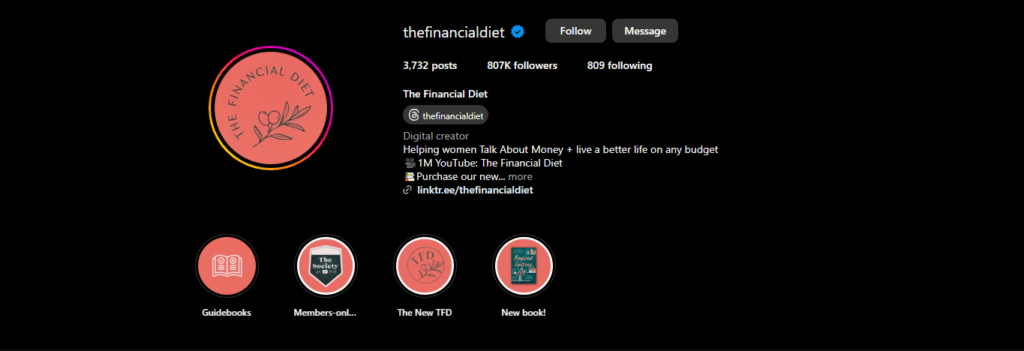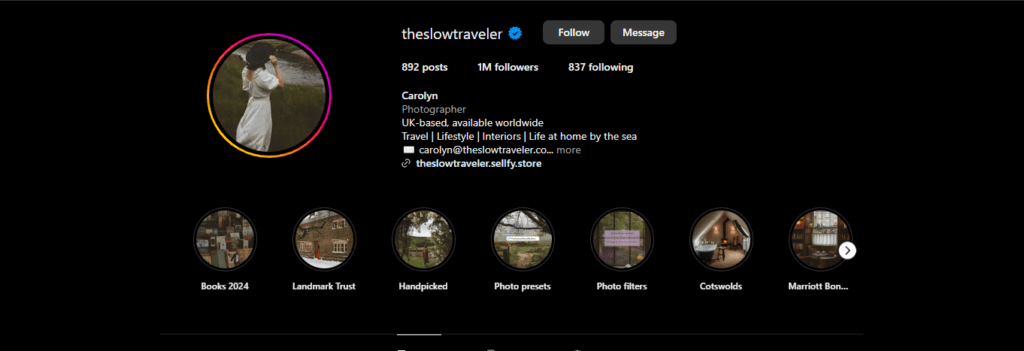Instagram isn’t just for selfies and food pics, it’s a powerful platform for bloggers looking to grow an audience, share their passion, and even make money.
If you’ve ever scrolled through Instagram and thought, “I could do this — maybe even better,” then this guide is for you. There are lots of successful creators who started just like you with little to no experince, the worst part is that most of them learned the hard way through trial and error but persisted till they succeed. And now instead of guessing, you’ll learn exactly how to start the right way, avoid common beginner mistakes, and grow faster than most new creators ever do.
Whether you’re a student, creative, side hustler, or a small business owner looking to build your brand, Instagram blogging (a.k.a. microblogging) is one of the fastest ways to share your interests online, grow an engaged audience, and potentially turn that content effort into a sustainable pasive income source, all from your phone.
What you’ll get from this guide
In this post, you’ll learn exactly how to start and grow an instagram blog, even if you’re starting from zero. We’ll cover:
- What an Instagram blog really is (and how it’s different from traditional blogging)
- Popular niches to get into, including ones with the most growth and earning potential
- A complete 8-step roadmap for launching your blog on IG
- Real-life examples of successful Instagram blogs
- How to monetize your Instagram blog and start earning
- Growth tips to stand out, get followers, and build a loyal community
- Limitations of using Instagram alone, and how to fix that with a smarter blogging strategy
Whether into foods, fashion tips, money tips, or sharing travel stories you can turn this into a monetized content brand.
Now let’s break it all down, step by step.
What Is An Instagram Blog?
An Instagram blog — also known as a vlog or microblog — is where you share eye-catching photos, videos, and short captions to tell stories, share ideas, or offer value around a specific niche. Instead of writing long blog posts, you deliver bite-sized content directly through your feed, Stories, and Reels.
It’s a powerful way to connect with an audience, build your personal brand, promote your main blog (if you have one), and even monetize through affiliate links, sponsored posts, or product sales.
How It’s Different from Traditional Blogging:
- Platform Ownership
- Instagram controls your reach and content visibility
- A traditional blog (that you own) gives you full control over your site, audience data, monetization options, and branding
- Content Format
- Instagram = short-form, visually engaging content
- Traditional blogs = long-form, searchable content that builds organic traffic over time
- Monetization Speed
- Instagram often requires a large following before monetization becomes viable
- A traditional blog can start making money from day one through affiliate links, ad networks, and digital products
- Traffic Sources
- Instagram growth relies on trends and algorithms
- A blog benefits from steady, passive traffic through SEO, email lists, and backlinks
If your goal is to build a scalable, income-generating platform, Instagram is a great starting point, but combining it with a traditional blog gives you the best of both worlds.
You can learn exactly how to do that in this guide:
👉 How to Start a Profitable Blog That Makes Money Fast, even if you’re starting from scratch.
How to Start a Blog on Instagram in 8 Steps
Here’s a step-by-step roadmap on how to set up and build a successful vlog on Instagram to attract and grow a royal audience or fans.
Step 1: Choose Your Niche
Pick a niche that aligns with your interests and expertise. You can pick from the examples the niches I mentioned earlier, which include:
Lifestyle and Personal Blogging
- Travel: Share your adventures and experiences.
- Fashion and beauty: Showcase your style and beauty tips.
- Fitness and health: Provide workout routines, healthy recipes, and wellness advice.
- Personal finance: Share tips on budgeting, saving, and investing.
- Parenting: Offer advice and support for parents.
Creative and Hobby-Based Niche
- Art and design: Showcase your artwork or design projects.
- Photography: Share your photography skills and tips.
- Music and entertainment: Discuss your favorite music, movies, or TV shows.
- Writing and literature: Share your writing and book recommendations.
- DIY and crafts: Showcase your DIY projects and tutorials.
Food and Cooking
- Healthy eating: Share healthy recipes and meal plans.
- Vegan or vegetarian cooking: Focus on plant-based cuisine.
- International cuisine: Explore different cuisines from around the world.
- Baking: Share your baking creations and recipes.
- Food photography: Showcase your food photography skills.
Business and Entrepreneurship
- Digital marketing: Share tips and strategies for online marketing.
- Freelancing: Offer advice on freelancing and remote work.
- Small business tips: Provide guidance for starting and running a small business.
- Entrepreneurship: Share your entrepreneurial journey and lessons learned.
Other Popular Niches
- Fitness and workouts
- Gaming
- Tech and gadgets
- Education and learning
- Home decor and design
- Pet care and animals
- Humor and comedy
Tip: Find more niches
Note: Choose a niche that you’re interested in and that aligns with your expertise. This will make it easier to create engaging content and build a loyal following over time without quitting early.
Step 2: Set Up Your Instagram Account
- Create a New Account (if you don’t want to use your personal account or if you don’t have one):
- Download the Instagram app or use the web version and sign up using your email or phone number.
- Username: Make sure it reflects your niche or personal brand (e.g., @fitfoodjourney).
- Switch to a Business or Creator Account:
- Go to your profile > Tap the three lines at the top right > Settings > Account > Switch to Professional Account.
- Choose between Business (for brands) or Creator (for influencers/bloggers).
- Optimize Your Profile:
- Profile Picture: Use a clear, professional-looking image (logo or personal photo).
- Bio: Craft a bio that tells people who you are, what your blog is about, and why they should follow you. Include keywords relevant to your niche.
- Add a Link: Use the link in your bio to direct followers to a website, blog, or landing page (you can use tools like Linktree to add multiple links).
Congratulations!
At this point, you will have an Instagram account ready to make posts, engage with your audience, and grow over time.
Step 3: Create a Content Strategy
- Content Pillars: Decide on 3-5 core topics that your content will cover. For example, a fitness Instagram blog might include workout tips, healthy recipes, personal progress, etc.
- Post Types: Instagram offers various formats, such as:
- Posts (Images or Carousels): Share high-quality photos with captions.
- Stories: Temporary posts for quick updates or behind-the-scenes content.
- Reels: Short, engaging videos (ideal for tutorials or viral content).
- IGTV: Longer video content for detailed discussions or tutorials.
- Consistency is Key: Plan to post consistently (e.g., 3-5 times per week). Use scheduling tools like Later, Planoly, or Buffer.
Step 4: Create High-Quality Content
- Photography & Editing:
- Use a good camera or smartphone with good lighting.
- Apps like Lightroom, VSCO, or Snapseed can help you edit your photos to look professional and consistent.
- Write Engaging Captions:
- Tell a story, ask a question, or provide useful information in your captions.
- Use a mix of personal insights and valuable content to engage your audience.
- Add CTAs (Calls to Action) like “comment below,” “share your thoughts,” or “save this post.”
- Use Hashtags Effectively:
- Research and use niche-specific hashtags (you can use up to 30).
- Mix popular and less popular hashtags to increase visibility.
- Examples: #foodblogger, #healthyrecipes, #veganfoodlover.
Step 5: Engage With Your Audience
- Respond to Comments: Make sure to reply to comments and engage with your followers to build a community.
- DMs: Engage with your audience through direct messages. It helps create personal connections and encourages loyalty.
- Engage with Other Accounts: Like, comment, and interact with similar accounts in your niche to grow your presence and build connections.
Step 6: Grow Your Following
- Promote Your Instagram: Share your Instagram on other social platforms like Facebook, Twitter, or Pinterest. Mention it in your blog (if you have one) and add it to your email signature.
- Collaborate with Others: Partner with other influencers or bloggers in your niche for shoutouts, guest posts, or giveaways.
- Use Instagram Ads: As you grow, you can use paid promotion (ads) to target specific demographics and increase your reach.
- Be Consistent: Posting consistently (including stories and reels) helps keep your audience engaged and attracts new followers.
Step 7: Track Your Traffic Analytics
- Monitor Insights: Use Instagram’s in-built analytics to track your follower growth, engagement rates, and which posts perform best.
- Adjust Your Strategy: Based on your insights, tweak your content strategy to improve engagement and growth.
Step 8: Stay Updated with Instagram Trends
- Instagram frequently updates its features. Stay on top of trends like new Reel challenges or algorithm changes to stay relevant.
Examples of Blogs on Instagram
Below are some examples of Instagram blogs to inspire you.
Some of these accounts have millions of followers. This should not scare you at all, as they have been into it for years now and have published a lot of posts. If you spend the same amount of time and learn more, what works for you can grow faster, taking less time.
@yoga_girl (Health & Wellness Blog)

- Niche: Yoga, wellness, and mindfulness
- Overview: Focuses on yoga practices, meditation, and mental health. The blog offers inspiring posts, tutorials, and personal reflections on well-being and mindfulness.
@mylifesmuseum (Interior Design Blog)
- Niche: Home decor and interior design
- Overview: Shares minimalist and aesthetically pleasing home designs. The blog covers interior decorating tips, home renovations, and styling ideas for a cozy and stylish living space.
@thefinancialdiet (Personal Finance Blog)

- Niche: Financial education for millennials
- Overview: Provides advice on saving money, budgeting, and investing, specifically targeting millennials. The blog uses informative posts with graphics and text to engage followers on financial literacy topics.
@weworewhat (Fashion Blog)

- Niche: Fashion, lifestyle, and entrepreneurship
- Overview: Shares daily fashion inspirations, outfit ideas, and beauty tips. The blog also covers lifestyle topics and personal branding, appealing to fashion enthusiasts and young entrepreneurs.
@minimalistbaker (Food Blog)

- Niche: Simple, quick, and healthy recipes
- Overview: Focuses on plant-based, gluten-free recipes that require 10 ingredients or less. The blog shares beautifully photographed dishes with easy-to-follow recipes, appealing to health-conscious food lovers.
@theslowtraveler (Travel Blog)

- Niche: Slow travel and photography
- Overview: Emphasizes slow travel, capturing serene and picturesque landscapes. The blog focuses on enjoying the journey rather than the destination, promoting a laid-back travel style.
How to Monetize Your Instagram Vlog and Make Money
There are lots of ways you can make money from your food vlog on Instagram, but here are the three most relevant and efficient ways to do so in most cases.
- Affiliate Marketing: Join affiliate programs related to your niche (e.g., Amazon Affiliates, ShareASale). Include links in your bio or swipe-up links in stories (if you have 10k+ followers).
- Sponsored Posts: Once you have a decent following, brands may reach out for paid collaborations, or you can pitch to them directly.
- Sell Products or Services: Promote your own digital products (like eBooks or courses) or physical products.
Here is a simple guide on “How To Make Money Blogging.”
Tips & Strategies to Grow Your Instagram Blog
Growing an Instagram blog requires a combination of strategies to boost your reach, engage your audience, and build a loyal following. Here are tips and strategies to help you grow your Instagram blog effectively:
1. Post Consistently
- Consistency is key: Posting regularly (3-5 times per week) keeps your content fresh in your followers’ feeds.
- Optimal Times: Use Instagram Insights or tools like Later or Hootsuite to determine the best times to post when your audience is most active.
- Maintain Quality: Make sure you’re posting high-quality content, even if you’re posting frequently.
2. Leverage Hashtags Effectively
- Use Niche-Specific Hashtags: Research and use a mix of popular and less competitive hashtags in your niche to boost visibility.
- Example: If you’re a food blogger, you might use hashtags like #foodblogger, #healthyrecipes, or #veganfood.
- Hashtag Strategy:
- Use a mix of broad and specific hashtags to reach different audiences.
- You can use up to 30 hashtags, but focus on using relevant ones.
- Hashtag Groups: Save different hashtag sets to rotate them across your posts, helping you reach new users without repeating the same tags.
3. Engage with Your Audience
- Reply to Comments: Promptly respond to comments on your posts to foster engagement.
- Ask Questions in Captions: Encourage conversation by asking open-ended questions that your followers can respond to.
- Run Polls and Quizzes in Stories: Use Instagram’s interactive Story features to engage followers directly and get them involved with your content.
- DM Interactions: Personalize your engagement by replying to direct messages or initiating conversations with your followers.
4. Create High-Quality Visual Content
- Professional Photos & Videos: Use good lighting and high-resolution images. Editing tools like Lightroom, VSCO, and Canva can help make your visuals stand out.
- Reels and IGTV Videos: Take advantage of Instagram’s video formats. Reels are great for viral growth, and IGTV is perfect for more in-depth content.
- Aesthetic Consistency: Develop a consistent visual style (color scheme, filters) that aligns with your brand. This helps create a cohesive look for your Instagram feed.
- Carousels: Use multi-image posts to tell a story or provide more value (e.g., step-by-step guides, tutorials).
5. Use Instagram Stories Daily
- Stay Top of Mind: Posting regularly on Stories keeps you visible at the top of your followers’ feeds.
- Behind-the-Scenes Content: Share candid, behind-the-scenes moments to connect with your audience on a more personal level.
- Interactive Features: Use stickers, polls, quizzes, and countdowns to engage your audience.
- Story Highlights: Save valuable content into highlight reels on your profile for long-term visibility (e.g., tutorials, tips, or best posts).
6. Leverage Instagram Reels
- Take Advantage of Reels’ Reach: Reels tend to get more visibility and can even go viral due to Instagram’s algorithm favoring this format.
- Short, Engaging Content: Create short, entertaining, or educational clips that align with your niche. Use trending audio or challenges to gain attention.
- Consistency: Posting Reels regularly can help you reach new audiences and increase your visibility.
7. Write Engaging Captions
- Tell Stories: Use captions to add context to your posts, share stories, or give tips related to your niche.
- Include Calls to Action (CTAs): Prompt your audience to take action, such as “tag a friend,” “share your thoughts in the comments,” or “click the link in my bio.”
- Use Emojis & Line Breaks: Keep captions visually appealing by breaking up text with emojis and line breaks for easy reading.
8. Use Instagram Ads
- Promote Key Content: Invest in Instagram Ads to boost specific posts, stories, or Reels that have performed well organically.
- Target Your Audience: Use Instagram’s ad targeting options to reach the right demographics, including interests, location, and behaviors.
- Test and Learn: Run A/B tests to find the most effective content and audience combinations.
9. Optimize Your Bio
- Clear and Compelling Bio: Write a concise bio that tells new visitors who you are, what your blog is about, and why they should follow you.
- Call to Action: Include a CTA, such as “Follow for daily tips” or “Check out my latest blog post below.”
- Link in Bio: Add a link to your blog, product page, or a Linktree that hosts multiple links (if needed).
10. Track Your Analytics
- Use Instagram Insights: Monitor your performance using Instagram’s analytics tools. Look at metrics like engagement rate, reach, and impressions to understand what’s working.
- Optimize Based on Data: Identify which content resonates with your audience and create more of that. Adjust your strategy if certain posts or times of day aren’t performing well.
11. Be Patient and Persistent
- Growth Takes Time: Building an Instagram blog takes time and effort. Be patient, stay consistent, and don’t get discouraged by slow growth in the early stages.
- Experiment: Don’t be afraid to try new content types, strategies, or trends. Adapt and refine your approach as you learn what works best for your audience.
12. Engage with Trends
- Follow Trending Topics: Stay updated with Instagram trends such as challenges, audio tracks, or viral hashtags, and incorporate them into your content to boost visibility.
By consistently implementing these strategies, you’ll not only grow your Instagram blog but also build an engaged and loyal audience over time.
Instagram Vlog Limitations
- You don’t control the platform
- The audience you can reach is limited
- You can share profitable links effectively
- It requires creating high-quality videos and image content, which is difficult to maintain for a long time.
- You can’t monetize it till you’ve grown lots of followers.
Alternative: How To Start A More Profitable Blog and Make Money In 6 Steps
To make the most money as a blogger, you can start a more professional blog, on a platform that you own and control to get monetized from day one.
As an Instagram blogger, you need time to grow before monetizing your account, which may take months if not in few years.
Whereas with a standard blog, you can get started today, publish your first post the same day, monetize it with ads, and start making money immediately as your traffic grows.
On Instagram, you can make around $500 – $2k/month even after you’ve spent months and years growing your account while a standard blogger who has spent less time can make as much as $20k/month just like the food blog “Pinch of Yum” by Lindsay, who started the blog as a fourth-grade teacher, now she makes over $80k/month from her blog “Pinch of Yum”.
Here is how you can start a standard blog today and grow your income over time as you learn and get better.
- Step 1: Click on “HostGator“ to host your blog
- Step 2: Choose your preferred HostGator plan
- Step 3: Choose your preferred domain & complete your sign-up
- Step 4: Within your Hostgator account, “Install WordPress,” your blogging platform
- Step 5: Within WordPress, choose your blog theme [A Pre-built Site]
- Step 6: Remove, add, or customize the pre-designed pages, and you can also create and customize as many as possible blog posts as you want.
To some, this might be complicated even though it’s not. We have a complete, detailed post on how to start a highly profitable food blog and how you can make money from it. “How to Start a Profitable Food Blog That Makes Money”








